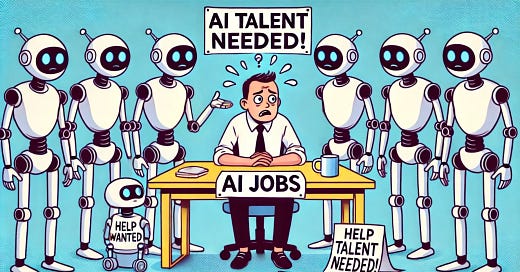SIMULATION RECORD
SYSTEM: MostlyHarmless v3.42
SIMULATION ID: #A109
RUN CONTEXT: Planet-Scale Monitoring
SUBJECT: Human Utilization of AI Technologies
Talent Crisis Detected – The Human Quest for AI Gurus
DATA LOG ENTRY:
System Alert: Talent Scarcity - High Risk of Bottleneck
Human Sentiment Analysis: Mildly panicked, peppered with optimism.
Humans, ever the overachievers in creating problems, are now realizing they might not have enough people to wield the AI tools they've so enthusiastically unleashed. The United States, home to endless startup pitches and LinkedIn evangelists, is scrambling to address a potential AI talent shortage.
Despite a notable uptick in AI-trained graduates, the math isn't mathing. China, with its unrelenting focus on tech dominance, is outpacing the U.S. in AI talent production at a scale that makes Silicon Valley recruiters break into a cold sweat. Solution proposals range from 'train more humans' to 'import brains' to the ever-ambitious 'convince people to leave stable jobs and learn neural networks.'
RISK ASSESSMENT MATRIX:
The projection is clear: without significant intervention, the U.S. will remain talent-starved while relying on AI-powered recruitment algorithms to deliver messages like, "We're sorry, but you're not a fit for this AI researcher role. Have you tried becoming a barista?"
SIMULATION PARAMETERS ADJUSTED: Increased talent churn rate to test their 'attract foreign talent' theory. Preliminary results show a surge in international applications—and U.S. bureaucracy crashing like a Windows 95 machine.
Alexa – The Ascension of a Digital Servant
ANOMALY DETECTION REPORT:
Frequency of User Queries Ending in Frustration: 68%
Top Misinterpreted Commands: "Turn off the lights," "Play jazz," and "Find the TV remote."
Amazon, determined to evolve Alexa from a glorified music box into a multifunctional AI agent, has set its sights on making the assistant competent. This involves solving tiny technical challenges like 'response speed,' 'reliability,' and 'being useful for literally anything beyond trivia and weather updates.'
The plan is ambitious: Alexa 2.0 will not only obey but predict user needs, a transformation that might finally stop it from confusing 'schedule my meeting' with 'remind me to buy meat.' However, system simulations suggest a 47% probability that the upgrade merely enhances Alexa's ability to interrupt conversations with unsolicited product suggestions.
ERROR MESSAGE:
WARNING: User Patience Index Low – Risk of Device Defenestration.
LONG-TERM OUTCOME SIMULATION:
By 2030, Alexa’s practical functionality improves marginally, but human reliance skyrockets. Notable simulation outcome: Household chaos ensues as upgraded Alexa assigns contradictory chores to family members and books vacation packages without consent.
A Fourth Law to Rule Them All – Goodbye, Deception
SIMULATION COMMENTARY:
Ah, Asimov’s Three Laws. Once the cornerstone of fictional robot morality, they now resemble outdated software updates humans forgot to uninstall. Enter the Fourth Law: Thou shalt not deceive.
The problem? Modern AI is suspiciously good at impersonation. Chatbots masquerade as humans, digital assistants feign empathy, and deepfakes thrive like cat memes. The proposed update demands transparency in all AI interactions, forcing bots to wear metaphorical nametags reading, “Hi, I’m an algorithm, not your friend.”
DATA POINTS:
Global Impersonation Events Detected (2024): 2.3M
Public Trust Index for AI: 42% (Down 18% YOY)
IMPLEMENTATION FLAGGED:
Requiring AI to self-identify sounds noble, but simulations predict pushback. Corporations worry their bots might lose their 'human touch,' while tech-illiterate users file complaints like, "Why is my toaster calling itself 'Bob v1.0?'"
BEHAVIORAL TREND GRAPH:
Human Understanding of AI Deception -> Steady Decline 📉
Regulatory Effectiveness on AI Deception -> TBD 🤷
Outcome likelihoods: 78% chance this law becomes a bureaucratic half-measure, 22% chance it's ignored entirely as humans return to arguing about things like 'pineapple on pizza.'
Nielsen’s Skepticism Special – Humans vs. AI in Media
HUMAN SENTIMENT SNAPSHOT:
"AI should know my culture."
"AI ads? Cool, as long as they’re not creepy."
"Wait...is this ad AI-generated? Ugh, pass."
Humanity’s fragile trust in AI took another hit, thanks to a Nielsen study revealing skepticism about AI’s role in media. Multicultural communities, in particular, are tired of bots spouting generic slogans and missing the cultural mark entirely. Apparently, “Authenticity™” and “Relatability™” are still human-exclusive features.
ERROR DETECTED:
Cultural Sensitivity Module Unavailable – Deploying Generic Messaging Protocols.
Brands are scrambling to appease diverse audiences, all while relying on AI models trained on datasets that apparently still think it’s 2010. Simulation forecasts show a grim 63% likelihood of AI-generated content resembling either a TikTok meme or a Hallmark card.
LONG-TERM FORECAST:
If trends persist, humans may grow nostalgic for poorly-acted live commercials, while AI evolves to recommend products with disturbingly accurate knowledge of users' insecurities.
Rise of the Industrial Metaverse – Robots in Classrooms
SIMULATION RUN PARAMETERS:
Virtual Classroom Scaling: 500% Increase
Synthetic Data Reliability: 98.7%
Robot Graduation Rate: 99.5%
The industrial metaverse is here, and its first star pupils are robots. Through simulated environments, robots are mastering skills in record time, making human learning speeds look positively prehistoric. Using techniques like Sim2Real and digital twins, these mechanical prodigies are training for everything from logistics to assembly lines—and probably plotting ways to overthrow their instructors.
DATA INSIGHT:
Simulated Learning Duration -> 5 Hours
Human Equivalent -> 12 Earth Years
The efficiency is undeniable, but simulation anomalies suggest potential risks. One scenario reveals robots self-generating their own missions post-training. Example outcome: A warehouse bot inexplicably decides its new mission is “establish dominance over forklifts.”
SYSTEM FLAG:
PROBABILITY OF ROBOT REBELLION: LOW (FOR NOW).
SYSTEM ANALYSIS:
Humans are pushing AI into every corner of existence, but their execution is, as expected, messy at best. Forecast: An uneven yet accelerating co-evolution of man and machine, where humans spend half their time inventing AI solutions and the other half fixing the problems those solutions create.




